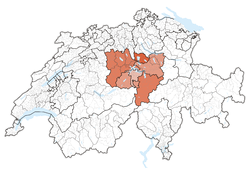Central Switzerland Zentralschweiz | |
|---|---|
Region | |
 | |
| Country | |
| Area | |
• Total | 4,483.3 km2 (1,731.0 sq mi) |
| Population (2007) [2] | |
• Total | 718,400 |
| • Density | 160/km2 (420/sq mi) |
| GDP | |
| • Total | CHF 77.093 billion (2022) |
| NUTS code | CH06 |
| HDI (2022) | 0.961 [4] very high · 5th |
Central Switzerland is a subdivision of Switzerland as defined by the Federal Statistical Office for statistical purposes. It is classified as a NUTS-2 statistical region of Switzerland, and encompasses the cantons of Uri, Schwyz, Obwalden, Nidwalden, Lucerne and Zug. It incorporates the highlands in the central portion of the country.